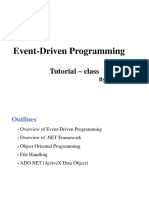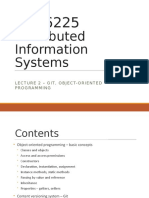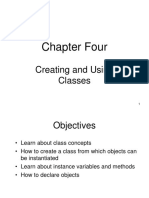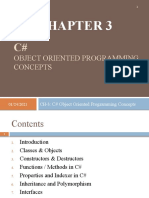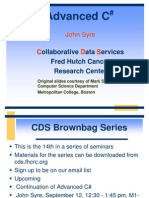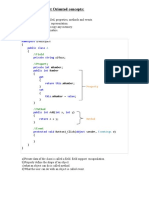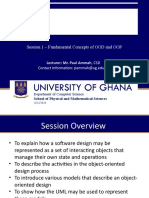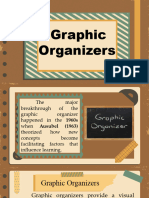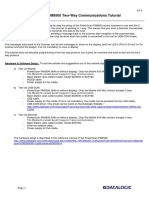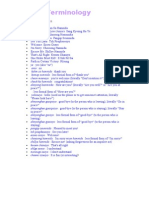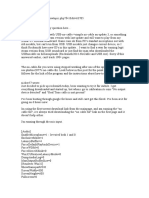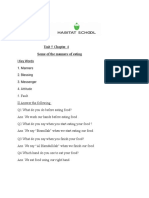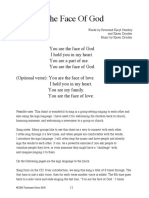Visual Programming
Course Overview & IDE Setup
Rida Bajwa
Recap …
• Previous Discussion:
⮚ Debugging and Error Handing
Today’s Discussion
⮚ Object Oriented Programming
⮚ Object, Fields and properties
⮚ Accessibility
⮚ Methods
⮚ Object lifecycle, Constructors & Destructors
⮚ Static Fields/Members
⮚ General OOP Concepts
OBJECT-ORIENTED
PROGRAMMING
WHAT IS OBJECT-ORIENTED
PROGRAMMING?
• Seeks to address many of the problems with traditional
programming techniques.
• The type of programming so far is known as procedural
programming
• results in so-called monolithic applications,
• meaning all functionality is contained in a few modules of code
(often just one)
• In traditional application, the flow of execution is often simple
and linear
• Applications are loaded into memory, begin executing at
point A, end at point B, and are then unloaded from
memory.
WHAT IS OBJECT-ORIENTED
PROGRAMMING?
• With OOP techniques, can use many more modules of code,
with each offering specific functionality.
• modules can be isolated or even completely independent of
the others.
• This modular method provides more versatility and code
reuse.
• For Example an example of engine replacement in a car
WHAT IS OBJECT-ORIENTED
PROGRAMMING?
• With OOP, things are rarely so linear, way of getting there is
often very different.
• firmly rooted in the structure and meaning of data,
• and the interaction between that data and other data.
• means putting more effort into the design stages of a
project, has the benefit of extensibility.
• OOP often simplifies things by providing an
agreement about
• the approach to data representation,
• the structure and usage of abstract entities
• For example, an agreement made with a device and
a printer,
What Is an Object?
What Is an Object?
• Everything in C# and the .NET Framework is an object
• An object is a building block of an OOP application.
• Encapsulates part of the application, which can be a
process, a chunk of data, or a more abstract entity
• Can represent a process by containing only functions
• Just like the variables created from types
• The type of an object is known by a special name “class”
• A class is the template, or perhaps the plans used to build
the object/instance.
Properties and Fields
• Provide access to the data contained in an object
• Make up the state of that object.
• Must provide it with a state for it to be meaningful
• Imagine an object class that represents a cup of coffee,
called CupOfCoffee
• set the type of coffee used,
• whether the coffee contains milk and/or sugar,
• whether the coffee is instant,
• and so on
Properties and Fields
• Properties differ from fields in that they don’t provide direct
access to data
• For fields can store values limited only by the limits of the
type used to store this information
• for example, for an int could use any value between
−2147483648 and 2147483647
• If a property is used could limit this value to, say, a number
between 0 and 2.
Properties and Fields
• Better to provide properties rather than fields for state
access
• have more control over various behaviors
• Read/write access to properties can also be clearly defined
by an object.
• properties can be read-only or write-only properties
• read-only property of the CupOfCoffee class called
Description
Accessibility
• Specify a sort of access permission for both fields and
properties
• determines which code can access these members
• available to all code (public),
• only to code within the class (private)
• Or its related one (protected)
• common practice is to make fields private and provide
access to them via public properties
Accessibility
• Code within the class has direct access to data
stored in the field
• Public property shields external users from this data
• Prevents them from placing invalid content
• Public members are said to be exposed by the class
Methods
• Method is the term used to refer to functions exposed by
objects
• used in the same way as any other function
• provide access to the object’s functionality.
• Like fields and properties, can be public or private,
restricting access to external code as necessary.
• Have access to private members
Methods
• Every command used has been a property or a
method, such as
• < String >.Length ,
• < String >.ToUpper() ,
• and so on.
The Life Cycle of an
Object
The Life Cycle of an Object
• Apart from the normal state of “being in use,” the life cycle
includes two important stages:
• Construction —When an object is first instantiated it needs
to be initialized.
• carried out by a constructor function
• often referred to simply as a constructor for convenience.
• Destruction —When an object is destroyed, there are often
some clean-up tasks to perform, such as freeing memory.
• The job of a destructor function, also known as a destructor
Constructors
• Basic initialization of an object is automatic
• to perform additional tasks during an object’s initialization
• All class definitions contain at least one constructor
• Can include a default constructor,
• A parameter-less method with the same name as the
class itself
• might also include several constructor methods with
parameters, known as nondefault constructors.
• perhaps providing initial values for data stored in the
object
Constructors
• constructors are called using the new keyword.
• CupOfCoffee myCup = new CupOfCoffee();
• CupOfCoffee myCup = new CupOfCoffee("Blue Mountain");
• can be public or private
• a class can’t instantiate an object using a private
constructor; it must use a public constructor.
• Some classes have no public constructors,
• it is impossible for external code to instantiate them (they
are said to be noncreatable)
Destructors
• Destructors are used by the .NET Framework to clean up
after objects.
• Provide specific instructions if anything important needs to
be done before the object instance is deleted.
• For example, when a variable goes out of scope
• to perform its garbage collection clean-up
• Don’t have to provide code, default operation does the work
Static and Instance Class Members
• Also known as shared members
• shared between instances of a class
• Can be thought of as global
• To access data that is independent of any object
• Execute commands related to the class type but not specific
to object instances
• don’t even need to instantiate an object
• For example, the Console.WriteLine() and Convert.ToString()
methods you have been using are static.
Static and Instance Class Members
• Many useful situations
• For example, using a static property to keep track of how
many instances of a class have been created.
Static Constructors
• To initialize static members beforehand.
• Can supply a static member with an initial value
• Can use a static constructor to perform this initialization
• Class can have a single static constructor,
• Must have no access modifiers and cannot have any
parameters.
• Can never be called directly
• Called only once
Static Constructors
• Executed when one of the following occurs:
• An instance of the class containing the static constructor
is created.
• A static member of the class containing the static
constructor is accessed.
• static constructor is called first, before the class is
instantiated or static members accessed.
• All non-static constructors are also known as instance
constructors
Static Classes
• Can never be instantiated
• Contain only static members and cannot be used to
instantiate objects
• such as Console
• Can’t have instance constructors
• Rather than making the constructors of the class private use
a static class
• Static classes can have a static constructor
OOP Concepts
OOP Concepts
• Encapsulation is the combination of the data and actions
that are related to an object.
• For example, a BankAccount type might have data,
such as Balance and AccountName, as well as
actions, such as Deposit and Withdraw.
• Composition is about what an object is made of.
• For example, a Car is composed of different parts, such
as four Wheel objects, several Seat objects, and an
Engine
OOP Concepts
• Aggregation is about what can be combined with an object.
• For example, a Person is not part of a Car object, but
they could sit in the driver’s Seat and then become the
car’s Driver—two separate objects that are aggregated
together to form a new component
• Inheritance is about reusing code by having a subclass
derive from a base or superclass.
• All functionality in the base class is inherited by, and
becomes available in, the derived class.
OOP Concepts
• Abstraction is about capturing the core idea of an object
and ignoring the details or specifics.
• C# has the abstract keyword.
• If a class is not explicitly abstract, then it can be
described as being concrete
• Base or superclasses are often abstract
• for example, the superclass Stream is abstract, and its
subclasses, like FileStream and MemoryStream, are concrete.
• Only concrete classes can be used to create objects;
• abstract classes can only be used as the base classes
because they are missing some implementation.
OOP Concepts
• Polymorphism is about allowing a derived class to override
an inherited action to provide custom behavior.
Wrap up
Summary
• We discussed:
⮚ Object Oriented Programming
⮚ Object, Fields and properties
⮚ Accessibility
⮚ Methods
⮚ Object lifecycle, Constructors & Destructors
⮚ Static Fields/Members
⮚ General OOP Concepts

















